The chimeric leucine-rich repeat/extensin cell wall protein LRX1 is required for root hair morphogenesis in Arabidopsis thaliana
- PMID: 11331608
- PMCID: PMC312681
- DOI: 10.1101/gad.200201
The chimeric leucine-rich repeat/extensin cell wall protein LRX1 is required for root hair morphogenesis in Arabidopsis thaliana
Abstract
In plants, the cell wall is a major determinant of cell morphogenesis. Cell enlargement depends on the tightly regulated expansion of the wall, which surrounds each cell. However, the qualitative and quantitative mechanisms controlling cell wall enlargement are still poorly understood. Here, we report the molecular and functional characterization of LRX1, a new Arabidopsis gene that encodes a chimeric leucine-rich repeat/extensin protein. LRX1 is expressed in root hair cells and the protein is specifically localized in the wall of the hair proper, where it becomes insolubilized during development. lrx1-null mutants, isolated by a reverse-genetic approach, develop root hairs that frequently abort, swell, or branch. Complementation and overexpression experiments using modified LRX1 proteins indicate that the interaction with the cell wall is important for LRX1 function. These results suggest that LRX1 is an extracellular component of a mechanism regulating root hair morphogenesis and elongation by controlling either polarized growth or cell wall formation and assembly.
Figures

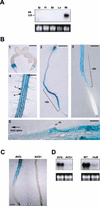
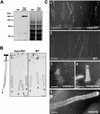
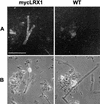

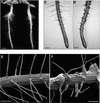
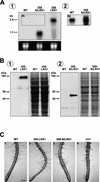
Similar articles
-
The hydroxyproline-rich glycoprotein domain of the Arabidopsis LRX1 requires Tyr for function but not for insolubilization in the cell wall.Plant J. 2010 Aug;63(4):662-9. doi: 10.1111/j.1365-313X.2010.04270.x. Plant J. 2010. PMID: 20545889
-
Synergistic interaction of the two paralogous Arabidopsis genes LRX1 and LRX2 in cell wall formation during root hair development.Plant J. 2003 Jul;35(1):71-81. doi: 10.1046/j.1365-313x.2003.01784.x. Plant J. 2003. PMID: 12834403
-
The Arabidopsis root hair cell wall formation mutant lrx1 is suppressed by mutations in the RHM1 gene encoding a UDP-L-rhamnose synthase.Plant Cell. 2006 Jul;18(7):1630-41. doi: 10.1105/tpc.105.038653. Epub 2006 Jun 9. Plant Cell. 2006. PMID: 16766693 Free PMC article.
-
Building a hair: tip growth in Arabidopsis thaliana root hairs.Philos Trans R Soc Lond B Biol Sci. 2002 Jun 29;357(1422):815-21. doi: 10.1098/rstb.2002.1092. Philos Trans R Soc Lond B Biol Sci. 2002. PMID: 12079677 Free PMC article. Review.
-
Planar polarity of root hair positioning in Arabidopsis.Biochem Soc Trans. 2007 Feb;35(Pt 1):149-51. doi: 10.1042/BST0350149. Biochem Soc Trans. 2007. PMID: 17233623 Review.
Cited by
-
Cell wall integrity signaling in plants: Malectin-domain kinases and lessons from other kingdoms.Cell Surf. 2018 Jul 27;3:1-11. doi: 10.1016/j.tcsw.2018.06.001. eCollection 2018 Sep. Cell Surf. 2018. PMID: 32743130 Free PMC article. Review. No abstract available.
-
ACTIN2 is essential for bulge site selection and tip growth during root hair development of Arabidopsis.Plant Physiol. 2002 Aug;129(4):1464-72. doi: 10.1104/pp.005777. Plant Physiol. 2002. PMID: 12177460 Free PMC article.
-
Antisense expression of a NBS-LRR sequence in sunflower (Helianthus annuus L.) and tobacco (Nicotiana tabacum L.): evidence for a dual role in plant development and fungal resistance.Transgenic Res. 2006 Apr;15(2):165-80. doi: 10.1007/s11248-005-3518-3. Transgenic Res. 2006. PMID: 16604458
-
Phosphate deficiency-induced cell wall remodeling: linking gene networks with polysaccharide meshworks.Plant Signal Behav. 2011 May;6(5):700-2. doi: 10.4161/psb.6.5.15051. Epub 2011 May 1. Plant Signal Behav. 2011. PMID: 21448004 Free PMC article.
-
LRX Proteins Play a Crucial Role in Pollen Grain and Pollen Tube Cell Wall Development.Plant Physiol. 2018 Mar;176(3):1981-1992. doi: 10.1104/pp.17.01374. Epub 2017 Dec 15. Plant Physiol. 2018. PMID: 29247121 Free PMC article.
References
-
- Baumann E, Lewald J, Saedler H, Schulz B, Wisman E. Successful PCR-based reverse genetic screens using an En-1–mutagenised Arabidopsis thaliana population generated via single-seed descent. Theor Appl Genet. 1998;97:729–734.
-
- Becker D, Kemper E, Schell J, Masterson R. New plant binary vectors with selectable markers located proximal to the left T-DNA border. Plant Mol Biol. 1992;20:1195–1197. - PubMed
-
- Bibikova TN, Zhigilei A, Gilroy S. Root hair growth in Arabidopsis thaliana is directed by calcium and an endogenous polarity. Planta. 1997;203:495–505. - PubMed
-
- Bibikova TN, Blancaflor EB, Gilroy S. Microtubules regulate tip growth and orientation in root hairs of Arabidopsis thaliana. Plant J. 1999;17:657–665. - PubMed
-
- Bradley DJ, Kjellbom P, Lamb CJ. Elicitor- and wound-induced oxidative cross-linking of a proline-rich plant cell wall protein: A novel, rapid defense response. Cell. 1992;70:21–30. - PubMed
Publication types
MeSH terms
Substances
Associated data
- Actions
LinkOut - more resources
Full Text Sources
Other Literature Sources
Molecular Biology Databases
